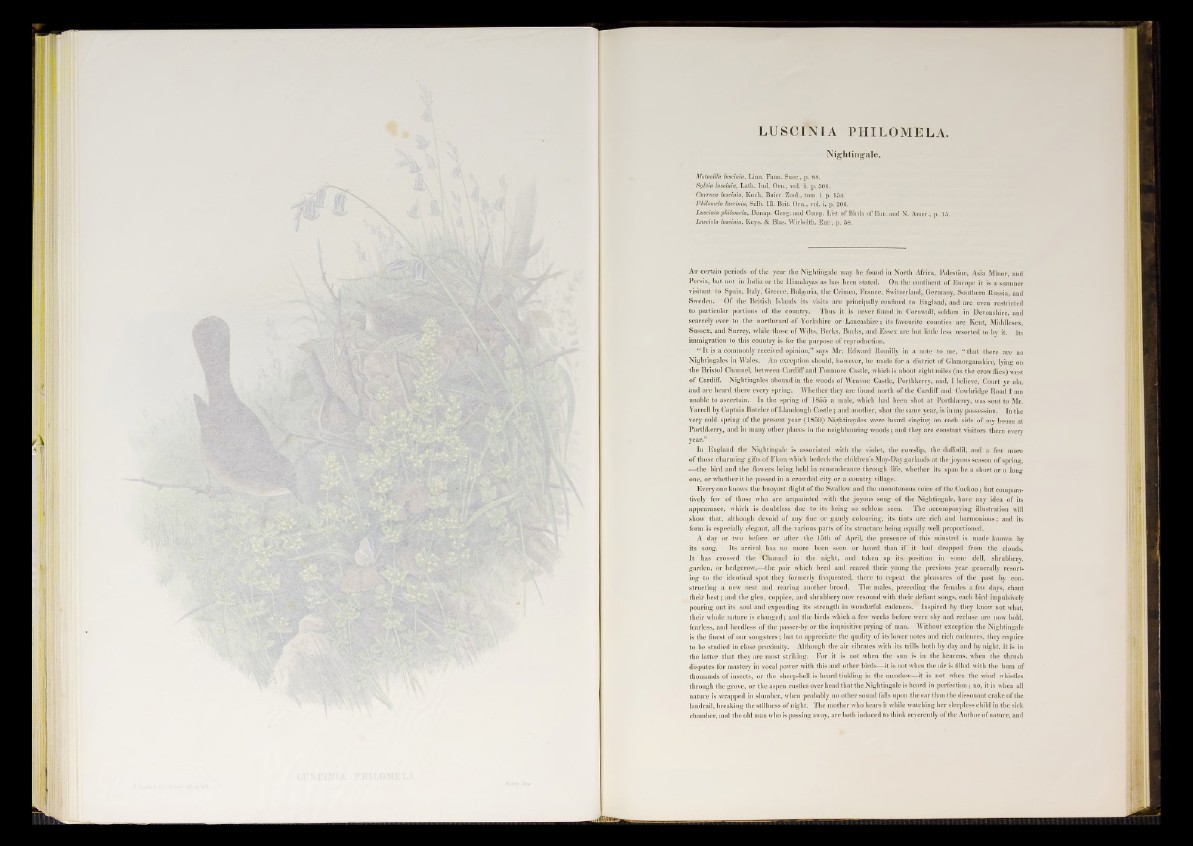
Nightingale.
Motacilla luscinia, Linn. Faun. Suec., p. 88.
Sylvia luscinia, Lath. Ind. Ora., vol. ii. p. 506.
Curruca luscinia, Koch, Baier. Zool., tom. i. p. 154.
Philomela luscinia, Selb. 111. Brit. Orn., vol. i. p. 206.
Luscinia philomela, Bonap. Geog. and Comp. List of Birds of Eur. and N. Amer., p. 15.
Lusciola luscinia, Keys. & Bias. Wirbelth. Eur., p. 58.
At certain periods of the year the Nightingale may be found in North Africa, Palestine, Asia Minor, and
Persia, but not in India or the Himalayas as has been stated. On the continent of Europe it is a summer
visitant to Spain, Italy, Greece, Bulgaria, the Crimea, France, Switzerland, Germany, Southern Russia, and
Sweden. Of the British Islands its visits are principally confined to England, and are even restricted
to particular portions of the country. Thus it is never found in Cornwall, seldom in Devonshire, and
scarcely ever to the northward of Yorkshire or Lancashire; its favourite counties are Kent, Middlesex,
Sussex, and Surrey, while those of Wilts, Berks, Bucks, and Essex are but little less resorted to by it. Its
immigration to this country is for the purpose of reproduction.
“ It is a commonly received opinion,” says Mr. Edward Romilly in a note to me, “ that there are no
Nightingales in Wales. An exception should, however, be made for a district of Glamorganshire, lying on
the Bristol Channel, between Cardiff and Fonmore Castle, which is about eight miles (as the crow flies) west
of Cardiff. Nightingales abound in the woods of Wenvoe Castle, Porthkerry, and, I believe, Court yr ala,
àud are heard there every spring. Whether they are found north of the Cardiff and Cowbridge Road I am
unable to ascertain. In the spring of 1855 a male, which had been shot at Porthkerry, was sent to Mr.
Yarrell by Captain Boteler o f Llandough Castle ; and another, shot the same year, is in my possession. In the
very cold spring of the present year (1859) Nightingales were heard singing on each side of my house at
Porthkerry, and in many other places in the neighbouring woods ; and they are constant visitors there every
year.”
In England the Nightingale is associated with the violet, the cowslip, the daffodil, and a few more
o f those charming gifts of Flora which bedeck the children’s May-Day garlands at the joyous season of spring,
.—the bird and the flowers being held in remembrance through life, whether its span be a short or a long
one, or whether it be passed in a crowded city or a country village.
Everyone knows the buoyant flight of the Swallow and the monotonous voice o f the Cuckoo; but comparatively
few o f those who are acquainted with the joyous song of the Nightingale, have any idea of its
appearance, which is doubtless due to its being so seldom seen. The accompanying illustration will
show that, although devoid of any fine or gaudy colouring, its tints are rich and harmonious; and its
form is especially elegant, all the various parts of its structure being equally well proportioned.
A day or two before or after the 15th of April, the presence of this minstrel is made known by
its song. Its arrival has no more been seen or heard than if it had dropped from the clouds.
I t has crossed the 'Channel in the night, and taken up its. position in some dell, shrubbery,
garden, or hedgerow,—the pair which bred and reared their young the previous year generally resorting
to the identical spot they formerly frequented, there to repeat the pleasures of the past by constructing
a new nest and rearing another brood. The males, preceding the females a few days, chant
their best ; and the glen, coppice, and shrubbery now resound with their defiant songs, each bird impulsively
pouring out its soul and expending its strength in wonderful cadences. ' Inspired by they know not what,
their whole nature is changed'; and the birds which a few weeks before were shy and recluse are now bold,
fearless, and heedless of the passer-by or the inquisitive prying of man. Without exception the Nightingale
is the finest of our songsters ; but to appreciate the quality of its lower notes and rich cadences, they require
to be studied in close proximity. Although the air vibrates with its trills both by day and by night, it is in
the latter that they are most striking. For it is not when the sun is in the heavens, when thé thrush
disputes for mastery in vocal power with this and other birds—it is not when the air is filled with the hum of
thousands of insects, or the sheep-bell is heard tinkling in the meadow—it is not when the wind whistles
through the grove, or the aspen rustles over head that the Nightingale is heard in perfection ; no, it is when all
nature is wrapped in slumber, when probably no other sound falls upon the ear than the dissonant crake of the
landrail, breaking the stillness of night. The mother who hears it while watching her sleepless child in the sick
chamber, and the old man who is passing away, are both induced to think reverently o f the Author of nature, and